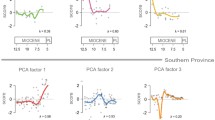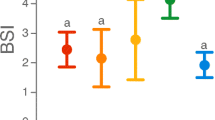Summary
Comparisons of prehistoric (A.D. 1100–1400) and extant cricetine-dominated rodent faunas from two locations in New Mexico and one in Arizona reveal temporal changes in both species diversity and taxonomic composition. The archaeological context of the prehistoric faunas permitted them to be dated rather accurately; paleoenvironmental inferences generated from other materials recovered in the excavations such as pollen samples, agricultural remains, and tree-ring specimens provided evidence about prehistoric environmental conditions in the study areas. Both richness and evenness components of diversity are lower in the present day faunas than in their prehistoric counterparts. At the beta (between-habitat or valley-wide) level of diversity the increased prehistoric species richness as well as the nature of the differences in present and prehistoric taxonomic composition can be accounted for by small climatic shifts which were occurring between A.D. 1100 and 1300 in the Southwest and the resultant biogeogrphic responses of certain rodent species. Alpha (or within-habitat) diversity is similar for all analyzed faunas. This suggests basic similarities in very local species packing despite observed spatial and temporal variation in valley-wide diversities. Environmental changes stemming from climatic shifts provide a reasonable explanation of the observed patterns of rodent species occurrence and diversity. Habitat destruction resulting from agricultural practies of prehistoric human populations appears to have had only a limited impact on these rodent communities.
Similar content being viewed by others
References
Anderson, S.: Mammals of Mesa Verde National Park, Colorado. University of Kansas Publications, Museum of Natural History 14, 29–67 (1961)
Bailey, V.: Mammals of New Mexico. North American Fauna No. 53, Bureau of Biological Survey, U.S. Department of Agriculture 1931
Bambach, R.K.: Species richness in marine benthic habitats through the Phanerozoic. Paleobiology 3, 152–167 (1977)
Beck, A.M., Vogl, R.J.: The effects of spring burning on rodent populations in a brush prairie savannah. Journal of Mammalogy 53, 336–346 (1972)
Bohrer, V.L.: Plant remains from rooms of Arizona, p. 14 (1). In: Multidisciplinary Studies at Grasshopper Pueblo, W.A. Longacre, ed., Arizona (in preparation)
Bryan, K.: The Geology of Chaco Canyon, New Mexico, in Relation to the Life and Remains of the Prehistoric Peoples of Pueblo Bonito, 122 pp. Smithsonian Miscellaneous Collections 1954
Cockrum, E.L.: The Recent Mammals of Arizona: Their Taxonomy and Distribution. Tucson: University of Arizona Press 1960
Connell, J.H.: Diversity in tropical rain forests and coral reefs. Science 199, 1302–1310 (1978)
Connell, J.H., Slatyer, R.O.: Mechanisms of succession in natural communities and their role in community stability and organization. American Naturalist III, 1119–1144 (1977)
Cook, S.F., Jr.: The effects of fire on a population of small rodents. Ecology 40, 102–108 (1959)
Cook, S.F.: Prehistoric demography. Addison-Wesley Module 16, pp. 1–42. Massachusetts: Reading 1972
Cutler, H.C., Meyer, W.: Prehistoric plant remains from the Gila Bend Area, W.W. Wosley and A.E. Johnson, eds. Antrhopological Papers, University of Arizona 9, 108–109 (1965)
Dean, J.S., Robinson, W.J.: Dendrochronology of Grasshopper Pueblo. In: Multidisciplinary Studies at Grasshopper Pueblo, Arizona, W.A. Longacre, ed., Anthropological Papers. Tucson: University of Arizona Press (in preparation)
Eddy, F.W.: Population dislocation in the Navajo Reservoir District, New Mexico and Colorado. Am. Antiquity 39, 75–84 (1974)
Findley, J.S., Jones, C.J.: Distribution and variation of voles of the genus Microtus in New Mexico and adjacent areas. Journal of Mammology 43, 154–166 (1962)
Findley, J.S., Harris, A.H., Wilson, D.E., Jones, C.: Mammals of New Mexico. Albuquerque: University of New Mexico Press 1975
Ford, R.I.: Three perspectives on Puebloan prehistory, pp. 19–39. In: A. Ortiz, ed., New Perspectives on the Pueblos. Sante Fe: School of American Research 1975
Fritts, H.C.: Tree-ring evidence for climatic changes in western North America. Mon. Weather Rev. 93, 421–443 (1965)
Fritts, H.C.: Tree Rings and Climate, 567 pp. New York: Academic Press 1978
Gennaro, A.L.: Northern geographic limits of four desert rodents of the genera Peromyscus, Perognathus, Dipodomys, and Onychomys in the Rio Grande Valley. American Midland Naturalist 80, 477–493 (1968)
Gould, S.J.: Palaeontology plus ecology as palaeobiology, pp. 218–236. In: R.M. May, ed., Theoretical Ecology. Philadelphia: W.B. Saunders Co., 317 pp., 1976
Goulden, C.E.: Temporal changes in diversity, pp. 96–102. In: G.M. Woodwell and H.H. Smith, eds., Diversity and Stability in Ecological Systems: Brookhaven Symposia in Biology, No. 22, 1969
Grant, P.R.: Interspecific competition among rodents. Ann. Rev. Ecol. Syst. 3, 79–106 (1972)
Hack, J.T.: The Changing Physical Environment of the Hopi Indians of Arizona. Papers of the Peabody Museum of American Archaeology and Ethnology, Harvard University, Vol. 35 (1) 1942
Harris, A.: Ecological distribution of some vertebrates in the San Juan Basin, New Mexico. Museum of New Mexico, Papers Anthropol. 8, 1–63 (1963)
Hastings, J.R.: Vegetation change and arroyo cutting in southeastern Arizona. J. Ariz. Acad. Sci. 1, 60–67 (1959)
Hevly, R.: Pollen Analysis of Quaternary Archaeological and Lacustrine Sediments from the Colorado Plateau. Ph. D. dissertation, Univ. of Arizona 1964
Holbrook, S.: Prehistoric Paleoecology of Northwestern New Mexico. Ph.D. Thesis, 212 pp. Berkeley: Univ. of Calif. 1975
Holbrook, S.: Rodent faunal turnover and prehistoric community stability in northwestern New Mexico. American Naturalist 111, 1195–1208 (1977)
Holbrook, S.: Habitat relationships and coexistence of four sympatric species of Peromyscus in northwestern New Mexico. Journal of Mammology 59, 18–26 (1978)
Holbrook, S.: Habitat utilization, competitive interactions, and coexistence of three species of cricetine rodents in east-central Arizona. Ecology 60, 758–769 (1979)
Holbrook, S.: Prehistoric environmental reconstruction by mammalian microfaunal analysis, Grasshopper Pueblo, Arizona. In: Multidisciplinary Studies at Grasshopper Pueblo, Arizona. W.A. Longacre, ed., Anthropological Papers. Tucson: Univ. of Arizona Press (in preparation)
Holbrook, S.J., Mackey, J.C.: Prehistoric environmental change in northern New Mexico: Evidence from a Gallina Phase archaeological site. The Kiva 41, 309–317 (1976)
Hooven, E.F., Black, H.C. 1976. Effects of some clearcutting practices on small mammal populations in western Oregon. Northwest Science 50, 189–208 (1976)
Hurd, L.E., Mellinger, M.V., Wolf, L.L., McNaughton, S.J.: Stability and diversity at three trophic levels in terrestrial ecosystems. Science 173, 1134–1136 (1971)
Huston, M.: A general hypothesis of species diversity. Am. Nat. 113, 81–101 (1979)
Jett, S.C.: Pueblo Indian migrations: An evaluation of the possible physical and cultural determinants. Am. Ant. 29, 281–300 (1964)
Kelley, J.C.: Factors involved in the abandonment of certain peripheral Southwestern settlements. Am. Anthropol. 54 (3), 356–387 (1952)
Kelso, G.K.: Two pollen profiles from Grasshopper Ruin. In: Multidisciplinary Studies at Grasshopper Pueblo, W.A. Longacre, ed., Anthropological Papers. Tucson: University of Arizona Press (in preparation)
Koplin, J.R., Hoffman, R.S.: Habitat overlap and competitive exclusion in voles (Microtus). Am. Mid. Nat. 80, 494–507 (1968)
Krefting, L.W., Ahlgren, C.E.: Small mammals and vegetation changes after fire in a mixed conifer-hardwood forest. Ecology 55, 1391–1398 (1974)
Lillywhite, H.B.: Effects of chaparral conversion on small vertebrates in southern California. Biological Conservation 11, 171–184 (1977)
LoBue, J., Darnell, R.M.: Effect of habitat disturbance on a small mammal population. Journal of Mammology 40, 425–437 (1959)
Longacre, W.A.: Population dynamics at the Grasshopper Pueblo, Arizona. Memoirs of the Society for American Archaeology No. 30, 71–74 (1975)
MacArthur, R.H.: Environmental factors affecting bird species diversity. Am. Nat. 98, 387–397 (1964)
Mackey, J.C., Holbrook, S.J.: Environmental reconstruction and the explanation of the abandonment of the Largo-Gallina Area, New Mexico. J. Field Archaeology 5, 29–49 (1978)
Olsen, S.J., Olsen, J.W.: A preliminary report of the fish and herpetofauna of Grasshopper Ruin. Kiva 36, 40–43 (1970)
Peterson, C.H.: The Paleoecological signficance of undetected short-term temporal variability. J. Paleo. 51, 976–981 (1977)
Porter, L.S.W.: Pleistocene Pluvial climates as indicated by present day climatic parameters of Crytotis parva and Microtus mexicanus. J. Mammalogy 59, 330–338 (1978)
Rodeck, H.G.: Sorex merriami and Microtus mexicanus in Colorado. Journal of Mammology 37, 436 (1956)
Rosenzweig, M.L., Winakur, J.: Population ecology of desert rodent communities: Habitats and environmental complexity. Ecology 50, 558–572 (1959)
Schoenwetter, J., Eddy, F.W.: Alluvial and Palynological reconstruction of environments, Navajo Reservoir District. Santa Fe: Museum of New Mexico Press 1964
Schoenwetter, J., Dittert, A.: An ecological interpretation of Anasazi settlement patterns. In: Meggars, B.J., ed., Anthropological Arachacology in the Americas. Washington, D.C.: Anthropological Society of Washington 1968
Schultz, C.B.: Holocene interglacial migration of mammals and other vertebrates. Quart. Res. 1, 337–340 (1972)
sellers, W.D., Hill, R.H.: Arizona Climate, 1931–1972. Tucson: University of Arizona Press 1974
Shannon, C.E., Weaver, W.: The mathematical theory of communication. Urbana: Univ. of Illinois Press 1963
Simberloff, D.S., Wilson, E.O.: The colonization of empty islands. Ecology 50, 278–295 (1969)
Sims, H.P., Buckner, C.H.: The effect of clearcutting and burning of Pinus banksiana forests on the populations of small mammals in southeastern Manitoba. American Midland Naturalist 90, 228–231 (1973)
Smartt, R.A.: The ecology of Late Pleistocene and Recent Microtus from south-central and southwestern New Mexico. Southwestern Naturalist 22, 1–29 (1977)
Tevis, L., Jr.: Responses of small mammal populations to logging of Douglas fir. Journal of Mammology 37, 189–196 (1956a)
Tevis, L., Jr.: Effect of a slash burn on forest mice. Journal of Wildlife Management 20, 405–409 (1956b)
Tramer, E.J.: Bird species diversity: Components of Shannon's formula. Ecology 50, 927–929 (1969)
Tuan, Yi-Fu, Everard, C.E., Widdison, J.C., Bennett, I.: The Climate of New Mexico, 197 pp. State Planning Office, Santa Fe 1973
Turkowski, F.J., Reynolds, H.G.: Response of some rodent populations to pinyon-juniper reduction on the Kaibab Plateau, Arizona. Southwestern Naturalist 15, 23–27 (1970)
Turkowski, F.J., Watkins, R.K.: White-throated woodrat (Neotoma albigula) habitat relations in modified pinyon-juniper woodland of southwestern New Mexico. Journal of Mammalogy 57, 586–591 (1976)
Wilson, D.E.: Ecological distribution of the genus Peromyscus in the Sandia Mountains, New Mexico. Southwestern Naturalist 13, 267–274 (1968)
Wilson, E.O., Simberloff, D.S.: Experimental zoogeography of islands: Defaunation and monitoring techniques. Ecology 50, 267–278 (1969)
Woodbury, R.B.: Prehistoric Agriculture at Point of Pines, Arizona. Memoirs of the Society for American Archacology No. 17 (1961)
Author information
Authors and Affiliations
Rights and permissions
About this article
Cite this article
Holbrook, S.J. Species diversity patterns in some present and prehistoric rodent communities. Oecologia 44, 355–367 (1979). https://doi.org/10.1007/BF00545240
Received:
Issue Date:
DOI: https://doi.org/10.1007/BF00545240




